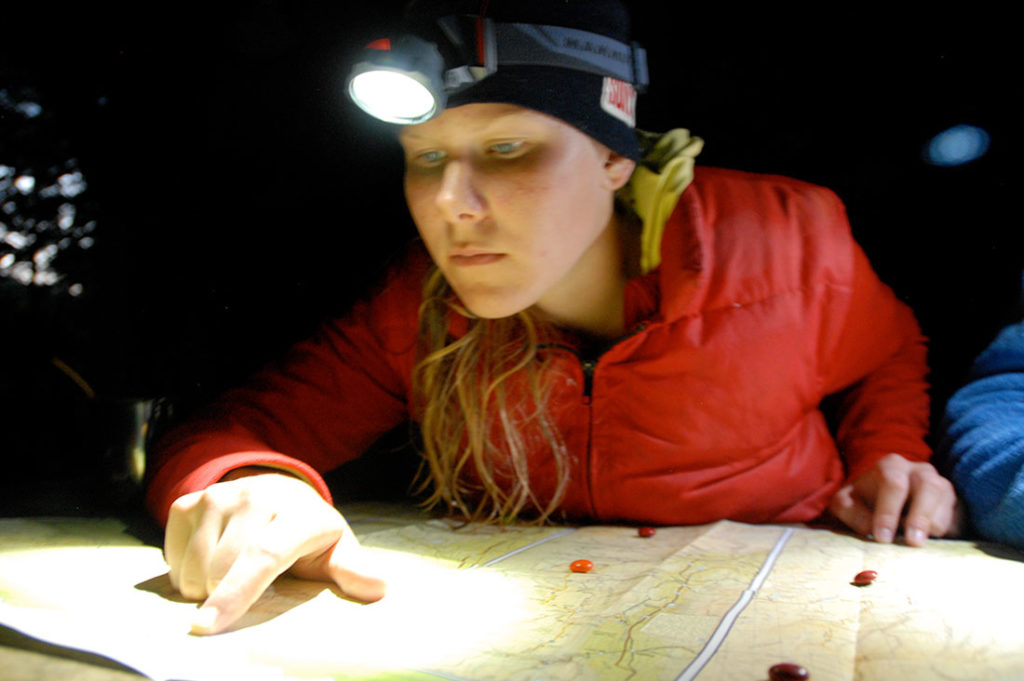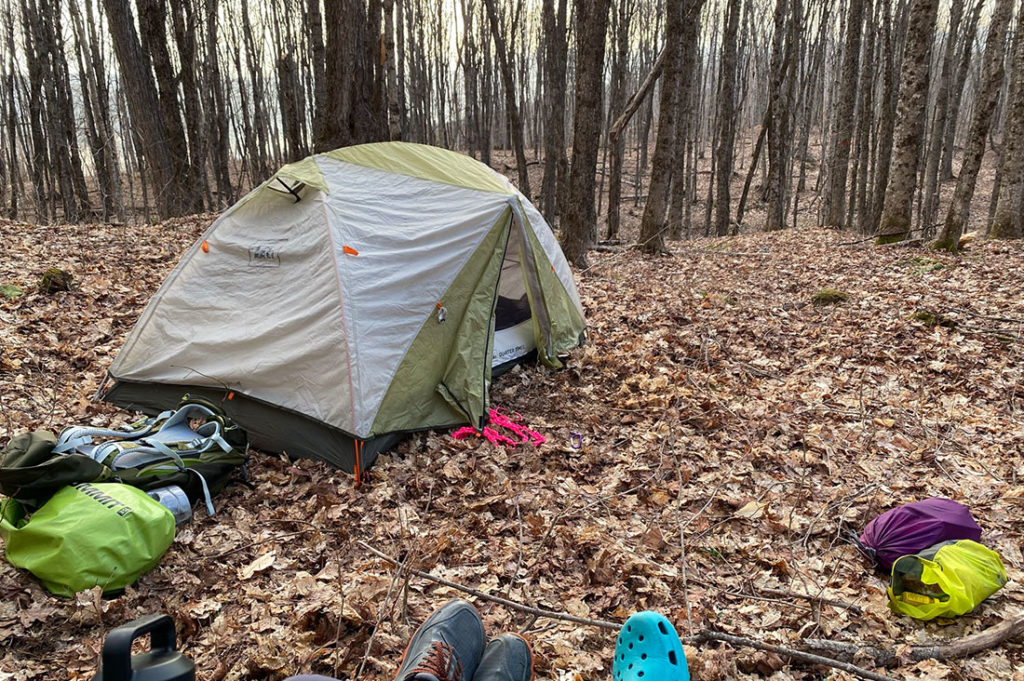
Autumn is Vermont’s best known season, and with such vibrant forests, it’s easy to see why. Fall hiking is a favorite past-time with its crisp temperatures, clearer views, and uncrowded trails. But don’t be fooled by the welcoming vistas; fall hiking comes with its challenges and preparedness is of utmost importance. Create a memorable trip without the drama by following these planning guidelines below.
What should I wear?
Fall is finally here, but the days are shorter and the temperatures dropping. The high mountain summits are already dusted with snow and ice, so it’s essential to layer for the cold even if temperatures are pleasant at base level.
Start with a synthetic wicking base layer on both top and bottom; add an insulating middle layer, and be sure to top it off with a water- and wind-proof outer shell later. Fall can present snow, rain, and mud, so it’s also important to accessorize with wool socks, a winter hat, lightweight gloves, and waterproof boots. Pack heavier layers, spare socks, and extra traction (like microspikes) in case backup is needed.
Because fall kicks off Vermont’s hunting season, it’s important to wear a blaze orange and avoid brown and gray clothing. All land crossed by the Long Trail is open to hunting. Review more safety tips for hiking during hunting season.
What safety considerations are there during fall hiking?

As fall hiking commences, leaves can hide the trail, ice and snow will await hikers at summits, and darkness can set in unexpectedly. The 10 Essentials and HikeSafe become even more important for a successful, fun outdoor experience. Plan ahead and follow these tips:
Fallen leaves hide rocks, roots, and other tripping hazards, and when wet, they become extra slippery. Watch your footing as you make your way through the leaf coverage. Using hiking poles is a great way to maintain stability. Fallen leaves will also camouflage a once obvious trail; before you set off, familiarize yourself with the terrain, your route, and carry a map. Follow our how-to videos to learn how to orient with a map and compass.
While on trail, be sure to wear blaze orange and other bright colors. Vermont’s bear hunting season kicks off in September, with deer and turkey hunting following shortly thereafter. Avoid hiking during dawn and dusk due to low visibility, and be respectful of all trail users. Find more info on hiking during hunting season here.
As you approach mountain peaks, you will surely notice the temperature cool. Rain, snow, mud, and ice are all known to make an appearance in the fall season, so layer accordingly. While hiking on snow and ice, it’s critical to have the right footwear and proper traction. Choose from a variety of boot attachments — spike-less, spiked, or crampons — to ensure you’ll have enough grip in the ice. (Learn more about these recommendations and price break-downs.)
As you finish your day’s hike, you’ll want to reach camp or the trailhead before darkness sets in. But it’s easy to lose track of the shortening daylight hours. Give yourself plenty of time to get off the trail, and carry adequate light in case of an emergency. A headlamp and spare batteries are musts, even if you don’t plan to stay out after dark.
What are good autumn hikes to try?

Whether you’re new to hiking in Vermont or looking for a fresh perspective, we’ve listed the best fall day hikes by region and mileage. You can also check out these suggestions for best leaf-peeping:
- recommended day hikes for fall
- leaf peeping hikes in the Northeast Kingdom
- leaf peeping hikes in the Stowe area
- alternatives to popular leaf-peeping hikes
- leaf peeping hikes in the Killington area
- leaf peeping in the Manchester area
- people’s choice foliage hikes
Fall is such a great time to wrap up hiking challenges and/or explore new vistas. Check out this list of trail challenges, including the NEK Mountain Challenge.
What should I pack?
As temperatures drop and winter approaches, some winter hiking guidance applies. Layers and foot traction are crucial; after that, you need water and snacks as you burn more calories to keep warm. We like to pack a thermos of hot cider or coffee, as well as (at least) two liters of water. For snacks, look for something full of sugar and protein (like granola bars) that is easy to grip with cold hands.
Always pack emergency essentials like a headlamp, fire starter supplies, first-aid kit, etc., even if you’re just planning a short day-hike. See more on emergency planning below.
Hiking with children? We have the ultimate guide for dressing, transporting, and hiking with babies and toddlers.
Can I hike with pets? It’s not recommended that you bring dogs on trail during hunting season. If you have pets with you, dress them in blaze orange so they are visible, and keep them leashed. As the snow and ice set in, you may need more gear to keep your dog comfortable; consider a coat, booties, or paw wax to protect their feet. Check out these tips for hiking with dogs in the cold.
What else should I plan for?

Whenever entering the backcountry, safety is paramount. Before setting out, let someone know where you’re going, what trails you are hiking, and when you’ll return. Get started with our HikeSafe information.
Weather: Be sure to check the weather and daylight hours ahead of your trip. In most circumstances, higher elevations mean cooler temperatures, and alpine zones offer little wind cover. Summit forecasts can be found on Mountain Forecast and the National Weather Service’s Enhanced Mountain Point Forecast. Most importantly, be aware that mountain conditions can change quickly; know your limitations, accept when it’s time to turn back, and postpone your hike if necessary.
Emergencies: Your first-aid kit should include hand and toe warmers, a headlamp, waterproof matches and a whistle, an emergency blanket, duct tape, alcohol wipes, moleskin and adhesive bandages, safety pins, ibuprofen, a sewing needle and thread, and any personal medications you may need, just in case. Pro tip: don’t expect to be rescued. Know how to rescue yourself.
Leave No Trace: Despite slowed traffic, it’s still essential to leave nothing but footprints… or snowshoe prints. Learn how to minimize your impact on the environment so the trails, campsites, and waterways look just as beautiful come Spring.
Parking: Some popular trailheads aren’t accessible in winter. If you cannot park fully outside the travel lane, use an alternative parking area or choose a different trailhead. Additionally, respect winter parking signage. Visit newengland511 for information on road closures, road work, and incidents. Pro tip: stash a shovel and extra food, water, and layers in your vehicle in case of an emergency.
What about autumn camping?

Daylight hours in the fall can be glorious, but nighttime can be outright cold. A 20-degree sleeping bag is usually sufficient, especially if you wear all your layers on those colder nights. If buying a warmer bag isn’t in your budget, try the more economical option of a mummy liner for the bag you already have.
Camp fires can be a great way to stay warm this season, but make sure you follow Leave No Trace principles:
- Where fires are permitted, use established fire rings, fire pans, or mound fires and be wary of leaf litter.
- Keep fires small. Only use sticks from the ground that can be broken by hand.
- You’ll want to burn all wood and coals to ash, put out campfires completely, then scatter cool ashes.
Spruce Peak Shelter near Manchester and Beaver Meadow Lodge in Morristown are great camping destinations. They’re the only two shelters within the Long Trail system with wood stoves. Pro tip: only use dead or downed trees as firewood.
Another consideration is the wildlife. Bears and other animals are still active in the fall, especially as they prepare for winter. Make sure you not only have proper food storage — such as a bear canister, an Ursack, or food hang — but also know how to use it.
Thinking of thru-hiking? September is one of the best times to start a thru-hike with less insects, milder weather, and unobstructed views. A bigger consideration, though, is which direction to start your hike. If you head northbound, you’ll hit Vermont’s northern region in early October, when it’s colder and snow-prone. A southbound start might offer milder temps, but you’ll also start on the more difficult northern terrain. Learn more about an autumn thru-hike here.
Ready for your hike? Remember, we’re here to support a safe and fun journey. If you have any lingering questions, check our website or reach out to us directly: [email protected]. Happy trails!


















